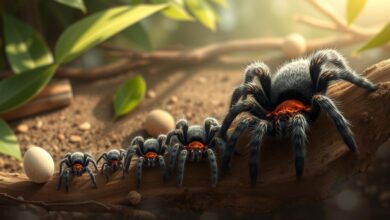How many babies does a tarantula have?
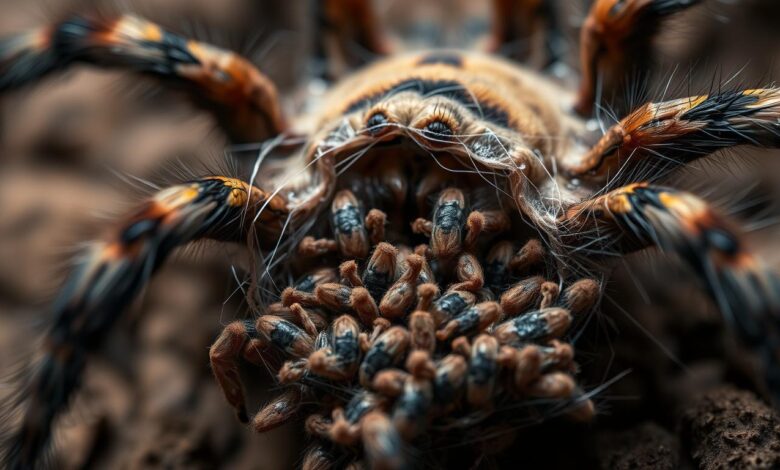
Tarantulas are amazing arachnids that many find fascinating. They have a unique way of reproducing. The number of babies a tarantula can have varies a lot. This depends on the species and the environment.
Looking into tarantula reproduction helps us understand their life cycle better. It includes mating, the egg sac, and spiderlings.
Learning about tarantula reproduction is important. It shows how these creatures are amazing. From the mating dance to the egg sac, each step is vital.
By exploring what affects their reproductive success, we can learn more. This helps us understand how many babies a tarantula can have.
Tarantula Reproduction: Unveiling the Mysteries
Tarantula reproduction is a fascinating and complex process. It shows the intricate dance of these arachnids. From the delicate courtship rituals to the factors influencing their reproductive success, understanding tarantula mating behaviors offers a glimpse into their remarkable adaptations.
Understanding the Tarantula’s Mating Process
The mating process of tarantulas is a carefully choreographed affair. Tarantulas engage in a series of intricate courtship behaviors. This includes the male’s intricate dance and the female’s receptiveness. This delicate dance is a crucial step in the successful mating of these spiders.
Factors Influencing Reproductive Success
The reproductive success of tarantulas can be influenced by several factors. These include environmental conditions, age, and overall health. Factors such as temperature, humidity, and availability of resources can all play a role in their mating and breeding success. Understanding these key variables is essential for those interested in tarantula breeding or observation.
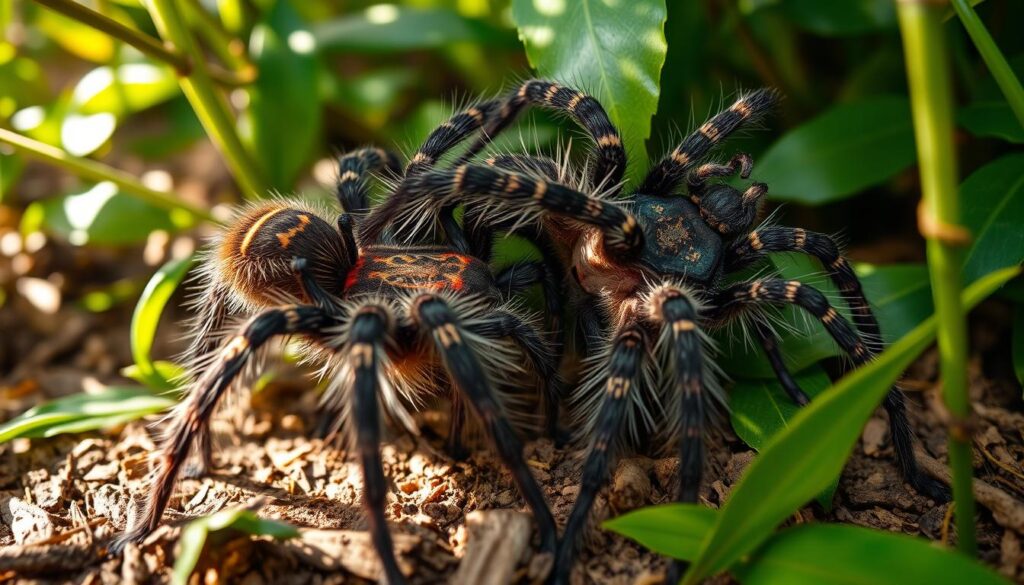
By delving into the mysteries of tarantula reproduction, we can gain a deeper appreciation for these fascinating creatures. Whether you are a seasoned tarantula enthusiast or simply curious about the natural world, exploring their mating rituals and reproductive strategies can be a truly captivating experience.
The Tarantula Egg Sac: A Protective Haven
The story of tarantula reproduction is full of wonder, especially the egg sac creation. After mating, the female tarantula builds a safe cocoon called the tarantula egg sac. This cocoon is a home for her tarantula spiderlings.
The egg sac is a natural wonder, keeping the eggs safe from predators and bad weather. It can hold between 100 to 1,000 eggs, depending on the species. Female tarantulas lay these eggs once a year, sometimes more often based on the environment and species.
The growth of the spiderlings inside the egg sac is slow and careful. It takes about 6 to 8 weeks for the eggs to hatch. This long wait helps more young tarantulas survive, as the egg sac protects them when they are most vulnerable.
| Tarantula Species | Average Eggs per Sac | Incubation Period |
|---|---|---|
| Curly Hair Tarantula | 100-400 | 6-8 weeks |
| Goliath Birdeater | 500-1,000 | 6-8 weeks |
| Chilean Rose Tarantula | 50-200 | 6-8 weeks |
The tarantula egg sac is a natural wonder, showing how tarantulas adapt to protect their young. As the spiderlings grow inside, they are ready to start their own adventures. They will amaze people and scientists with their journey.
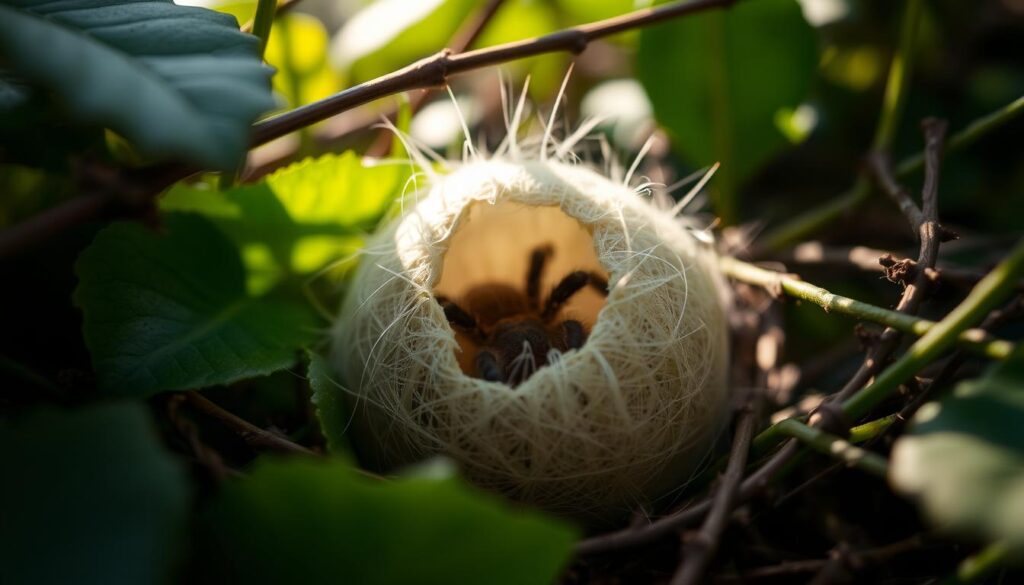
How many babies does a tarantula have?
Curious about tarantulas’ reproductive power? You’re in for a treat. These amazing arachnids can have hundreds or thousands of babies.
Exploring the Number of Spiderlings
The number of spiderlings varies by tarantula species. Smaller ones might have a few dozen, while bigger ones can have hundreds or thousands.
The Poecilotheria metallica, or Gooty Sapphire Ornamental Tarantula, can have 100 to 200 spiderlings. The Lasiodora parahybana, or Brazilian Salmon Pink Birdeater, can have up to 2,000 eggs, leading to a similar number of hatchlings.
Size, age, health, and environment affect how many spiderlings a tarantula can have. Bigger, older, and healthier females usually have more babies. Younger or smaller ones might have fewer.
| Tarantula Species | Number of Spiderlings |
|---|---|
| Poecilotheria metallica (Gooty Sapphire Ornamental Tarantula) | 100 to 200 |
| Lasiodora parahybana (Brazilian Salmon Pink Birdeater) | 1,000 to 2,000 |
| Brachypelma albopilosum (Curly Hair Tarantula) | 50 to 100 |
| Grammostola rosea (Chilean Rose Tarantula) | 75 to 150 |
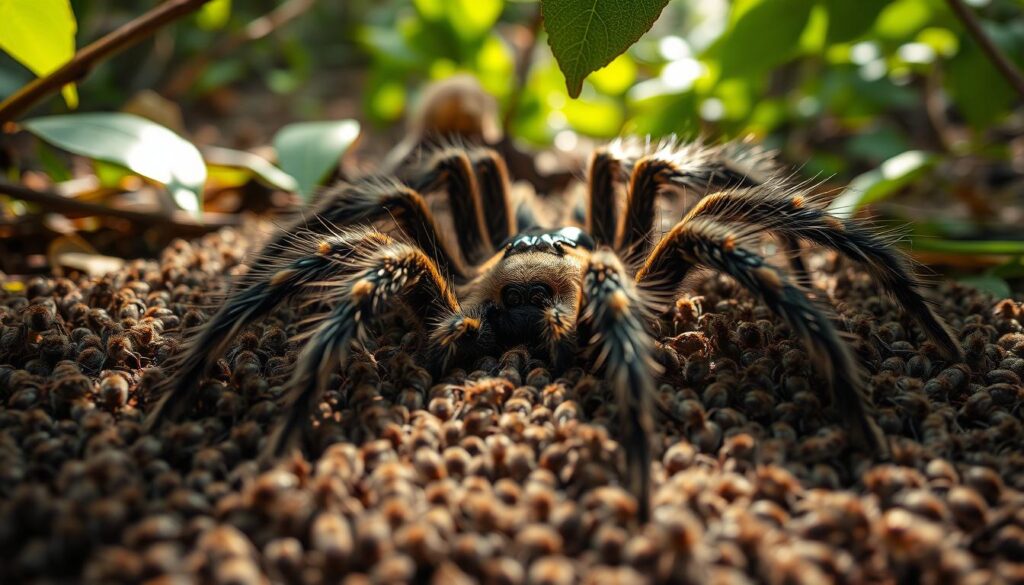
Looking into how many spiderlings different tarantulas have shows their varied ways of reproducing. It’s a fascinating look into their biology.
Tarantula Spiderlings: A Fascinating Journey
The life cycle of a tarantula is truly captivating. From the moment they hatch, tarantula spiderlings start an amazing journey. They go through many molts and growth stages, turning into the powerful predators we know as tarantulas.
Development and Growth Stages
Tarantula spiderlings change a lot as they grow. They molt, shedding their skin to grow bigger and change. This process, called ecdysis, is key for their growth and maturity.
As they grow, they look different. Their bodies get stronger, their legs and fangs grow, and their colors change. This shows how resilient and adaptable these creatures are.
| Growth Stage | Characteristics |
|---|---|
| Spiderling | Tiny, delicate, and newly hatched |
| Juvenile | Larger, with more defined features |
| Subadult | Nearly full-sized, with mature coloration |
| Adult | Fully developed, capable of reproduction |
Learning about the growth of tarantula spiderlings helps us appreciate their life cycle. From tiny hatchlings to powerful adults, their journey is a wonder of nature.
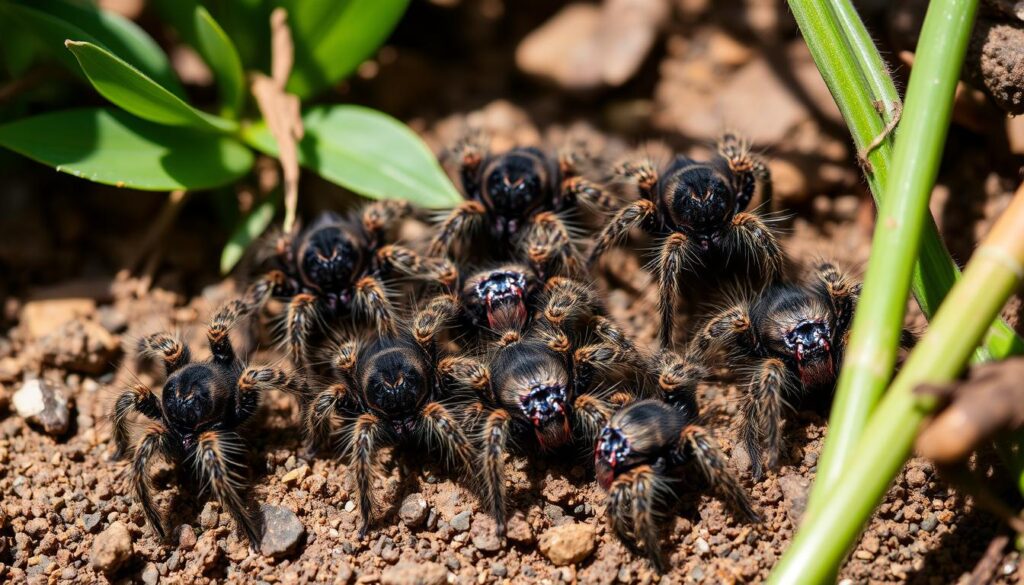
Tarantula Breeding: A Captivating Endeavor
Tarantula breeding is both complex and fascinating. People spend hours learning about tarantula reproduction. They study mating rituals and care for egg sacs and spiderlings. This study of tarantulas is inspiring and captivating.
To breed tarantulas successfully, you need to know their unique behaviors and needs. Things like temperature, humidity, and substrate are key. Breeders carefully watch these factors to keep their tarantulas healthy.
The mating process is a delicate dance. Males go through courtship rituals to impress females. After mating, the female builds an egg sac for her babies. The spiderlings that come out are tiny and need special care.
The journey from courtship to spiderling emergence is fascinating. It’s a journey that captivates both experts and newcomers. By studying this process, we learn more about tarantulas’ resilience and adaptability.
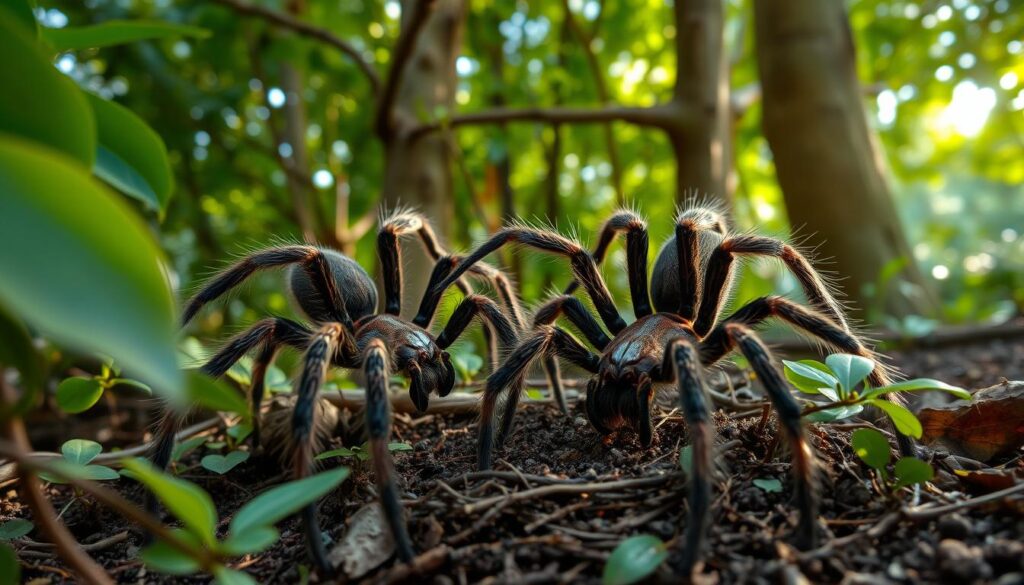
The Tarantula Life Cycle: An In-Depth Look
Tarantulas change a lot from tiny spiderlings to big, hairy spiders. This amazing journey shows how adaptable and strong they are. Let’s dive into the tarantula life cycle and see what makes them so special.
From Spiderlings to Adulthood
When tarantula eggs hatch, the spiderlings are very weak. They face many dangers and tough conditions. But, many spiderlings grow strong and become the big spiders we know.
As they grow, they shed their skin in a process called molting. Each molt brings them closer to being adults. They get bigger, change color, and learn new things. This shows how flexible and smart tarantulas are.
The tarantula life cycle is full of surprises. It shows how these spiders can survive and thrive. From tiny spiderlings to big adults, tarantulas are amazing. Learning about their life cycle helps us understand the natural world better.
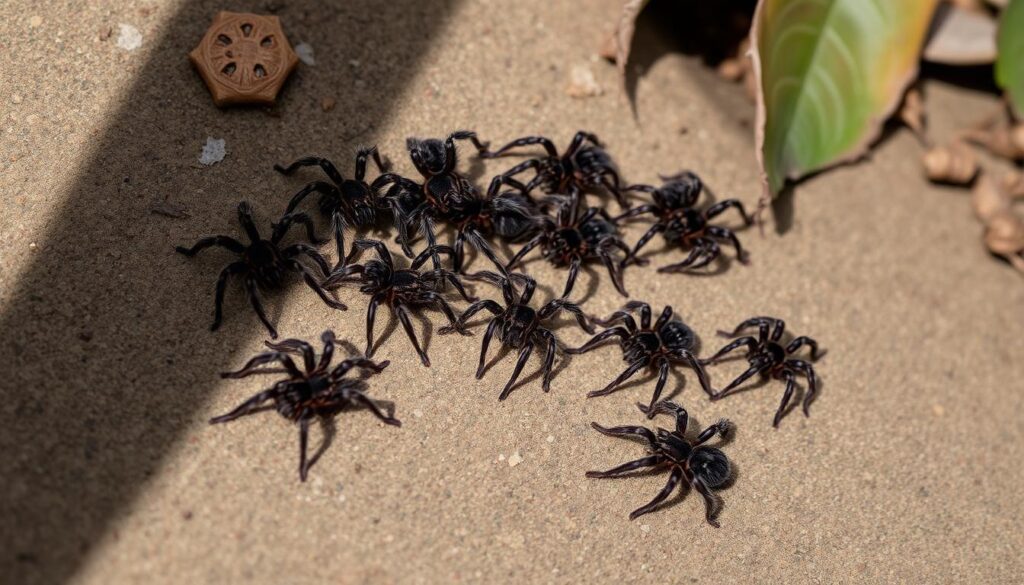
| Tarantula Spiderling Survival Rates | Percentage |
|---|---|
| Mortality rate among spiderlings in the wild | Relatively high |
| Factors affecting survival | Predators, environmental conditions, lack of parental care |
| Cannibalism among spiderlings | Common in some species |
| Average number of spiderlings per egg sac | 50 to over 200 |
Arachnid Reproduction: Similarities and Differences
Tarantulas are not the only fascinating creatures when it comes to arachnid reproduction. Exploring the similarities and differences between tarantulas and other arachnids like spiders shows the diversity and adaptations in the arachnid family. By comparing these reproductive mechanisms, we can understand the evolutionary paths that have led to their success and survival.
For example, female black widow spiders lay several masses of eggs in a single summer. Each egg case can hold 250 to 750 eggs. The young spiderlings emerge in 14 to 30 days after the eggs are laid. Female black widows can live over one and a half years, showing their remarkable longevity.
Wolf spiders also have unique reproductive strategies. Female wolf spiders can lay dozens of eggs or more after mating. They can carry their egg sacs around with them. After the spiderlings hatch, they climb onto their mother’s back and are carried for several days before venturing off on their own.
| Arachnid Species | Egg Laying | Egg Count | Hatching Time | Lifespan |
|---|---|---|---|---|
| Black Widow | Multiple egg masses per summer | 250-750 eggs per case | 14-30 days | Over 1.5 years |
| Wolf Spider | Several dozen eggs or more | Varies | Spiderlings carried by mother for days | 1 year for males, several years for females |
These examples show the fascinating diversity in the arachnid world. Different species have evolved unique reproductive strategies to ensure their offspring’s survival. By understanding the reproductive processes of different arachnids, we can gain deeper insights into their adaptations and evolutionary paths.
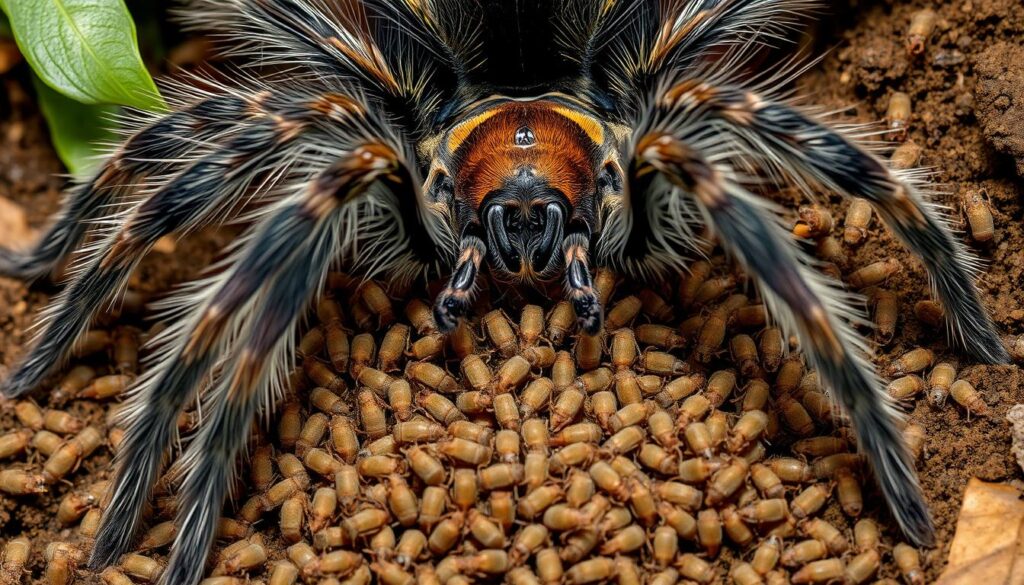
Spider Young: Survival Strategies in the Wild
For spider young and spider offspring, surviving in the wild is tough. They use many survival strategies to stay safe from predators and harsh environments. Learning about the special ways tarantula and spider young adapt helps us see their strength and flexibility.
One key survival tactic is blending in with their surroundings. Spider young have colors and patterns that match trees, rocks, or leaves. This camouflage helps them avoid being seen by predators, increasing their chances of growing up.
| Spider Species | Leg Span |
|---|---|
| Giant Huntsman Spider | 30 centimeters |
| Sand-Dwelling Huntsman Spider | Up to 14 centimeters |
| Brazilian Wandering Spider | Up to 18 centimeters |
| Colombian Giant Redleg Tarantula | 20 centimeters |
| King Baboon Spider | Up to 20 centimeters |
| Chaco Golden-Knee Tarantula | Up to 20 centimeters |
| Face-Sized Tarantula | Up to 20 centimeters |
| Brazilian Giant Tawny Red Tarantula | Around 23 centimeters |
| Brazilian Salmon Pink Birdeater | Up to 28 centimeters |
| Goliath Birdeater | Up to 30 centimeters |
Another survival method is being very agile and fast. This lets spider young dodge predators and find safe spots. Some spiders can even use special hairs or venom to scare off threats.
The survival strategies of spider young and spider offspring show their amazing adaptability. By learning how they face wild challenges, we can better appreciate the complex world around us.
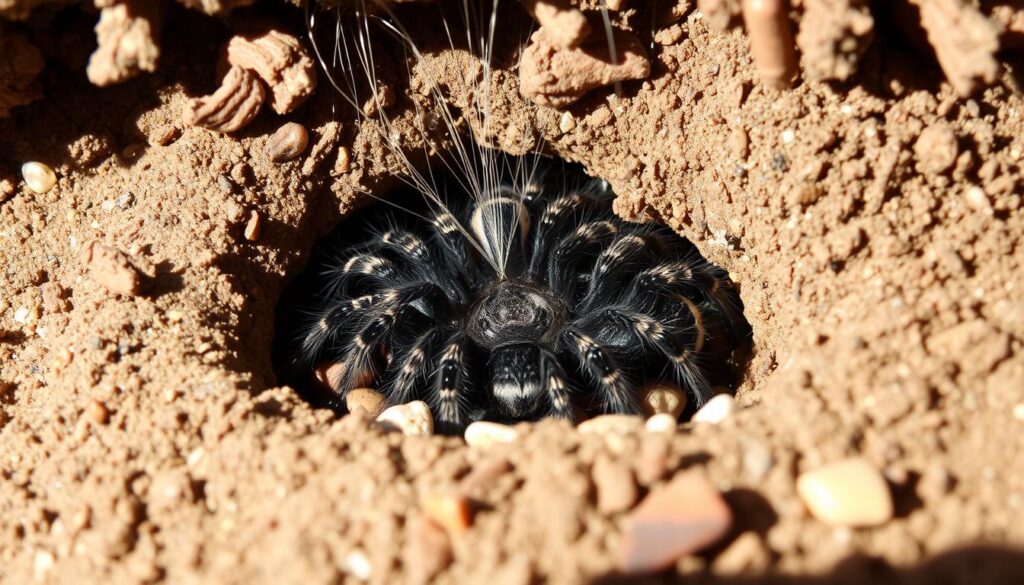
Tarantula Offspring: Unique Characteristics
Exploring tarantula offspring, or spiderlings, uncovers fascinating traits. These young arachnids show off unique colors and physical features. These traits highlight the diversity and adaptability of tarantulas.
Identifying Distinct Species
Looking into tarantula spiderlings reveals a world full of wonder. Each species has its own special features in its young. These can include size, shape, and body patterns.
- Color Variations: Spiderlings come in a wide range of colors. They can be bright red, blue, and yellow, or more subdued brown and gray. These colors help them hide or warn off predators.
- Unique Morphological Features: Some tarantulas have special features in their young. This can include unique leg shapes, special spines, or different eye arrangements.
- Behavioral Patterns: Spiderlings also show different behaviors. Some are calm, while others are bold. They may hunt or build webs in unique ways.
By studying tarantula spiderlings, we learn more about these amazing creatures. It helps us understand the diversity of tarantulas, one spiderling at a time.
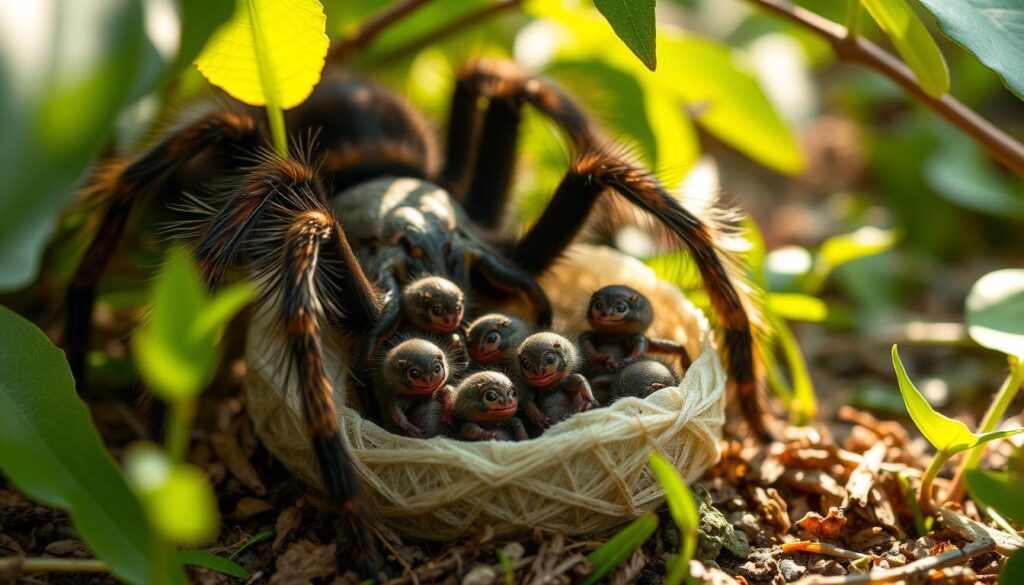
Spider Birth: Witnessing Nature’s Wonders
The process of spider birth and tarantula reproduction is amazing. Seeing the courtship rituals, the egg sac creation, and the young arachnids hatching is awe-inspiring. It shows us how complex and strong these creatures are.
Picture a male tarantula, marked with a bright bee marker, looking for a female to mate. After a dance, they mate, and the female takes care of the spider egg sac. This sac protects the spiderlings until they’re ready to start their lives.
As you watch, the egg sac starts to hatch. The spiderlings come out, showing the beauty of spider reproduction. Seeing them take their first steps is both captivating and humbling. It reminds us of the delicate balance in nature.
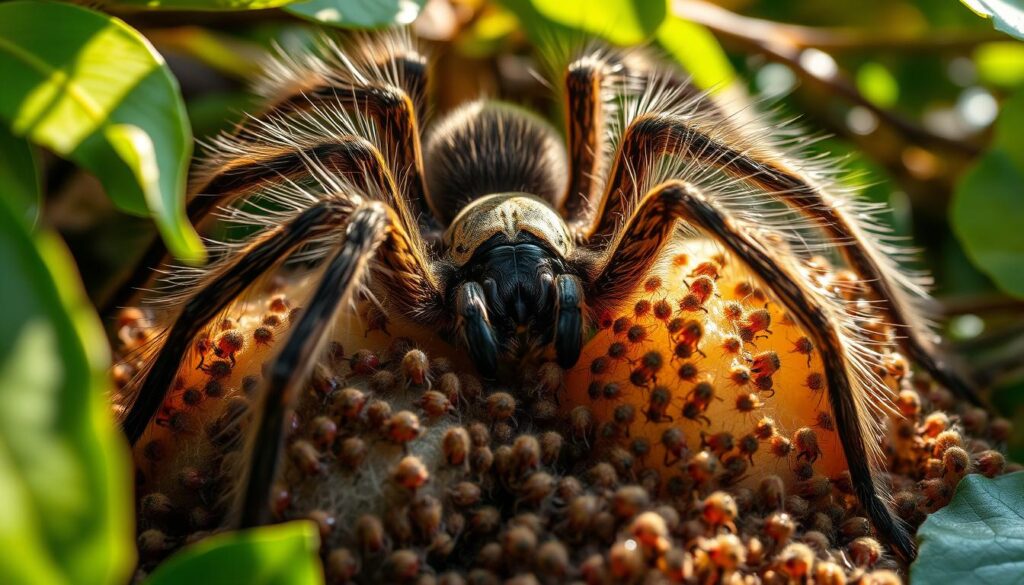
Whether you love nature or just want to learn about spiders, seeing spiderlings born is incredible. From the courtship to the egg sac, the tarantula reproduction shows their amazing survival skills.
Market Musing-g: Insights into Cryptocurrency Regulations
The world of cryptocurrency is always changing. This means the rules around digital assets are getting more attention. Wyoming Senator Cynthia Lummis is a big supporter of cryptocurrencies. She has spoken out against the U.S. Securities and Exchange Commission (SEC) on cryptocurrency regulations.
Senator Lummis is worried about how the SEC handles digital assets. She thinks we need better rules that help everyone. She believes the current rules are holding back the growth and new ideas in the cryptocurrency world. This could affect the whole financial system.
Lummis wants a balance between keeping investors safe and encouraging new ideas. She suggests the SEC should work better with the industry. This way, new rules can be made that fit the special needs of cryptocurrencies and other digital assets.
The talk about cryptocurrency regulations is ongoing. People in government and the industry are trying to figure out the good and bad of this fast-growing market. As the SEC and others make decisions, we’ll see how things change. And how these changes will affect the financial world.

Hooters Waitress Turns Silent Slasher in Indie Horror Flick
Liana Pirraglia, a Hooters waitress from Long Island, New York, has made her acting debut in the indie horror film “Stream.” She wasn’t a big fan of horror movies but landed the role of “Player 3,” a silent slasher. Her performance has won praise in the horror world, with fans loving her character’s costume.
Liana started at Hooters over three years ago, part-time. But acting, modeling, dancing, singing, and horror movies have always been her passions. “Stream” was released in the U.S., Canada, and Mexico, showing off her talent to more people.
The indie film, crowdfunded and shot in 2021, has won over critics and fans. Liana’s role as Player 3 is a hit, with fans dressing up as her. Her costume is a favorite among cosplay fans.
Liana may not love horror movies, but she’s diving into the horror world. She plans to meet fans at conventions. Her success has only made her more excited to act and see where it takes her.

| Statistic | Value |
|---|---|
| Years Liana has worked at Hooters | Over 3 years |
| Countries where “Stream” was released | America, Canada, and Mexico |
| Year “Stream” began production | 2021, right after lockdown |
| Liana’s previous appearances | TLC’s Toddlers in Tiaras |
Insect Larvae: The Pre-Adult Stage Uncovered
Exploring the world of insects, you’ll find a key stage: the larval phase. This is the pre-adult stage where insects change a lot before they become adults. Learning about insect larvae helps us understand their life cycles.
The crossword clue “An insect in a pre-adult state (5)” is answered with “LARVA.” This five-letter word captures the essence of the pre-adult stage. Insects like caterpillars and maggots show how diverse and unique larvae can be.
Insects’ early stages are often very different from their adult forms. This shows how they’ve adapted to live in many different places. Discovering insect larvae reveals a world full of wonders that show nature’s creativity.



